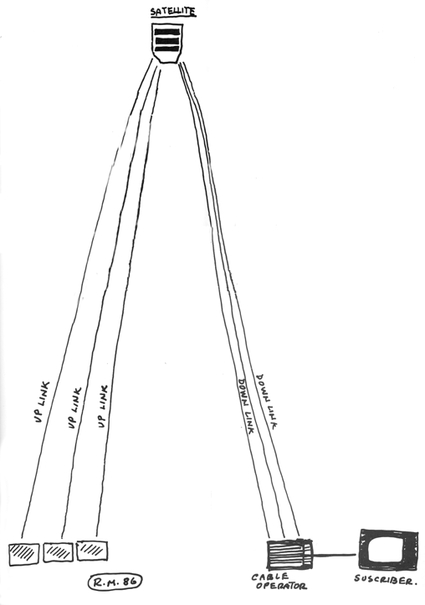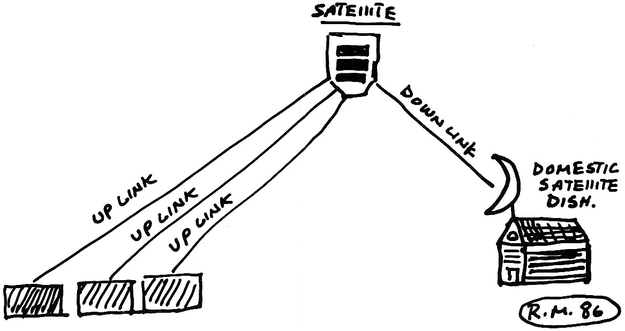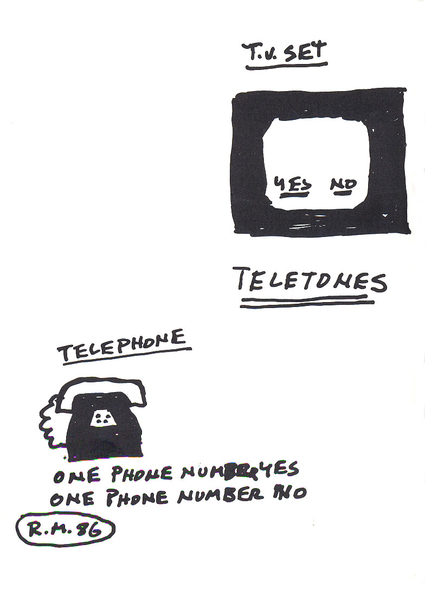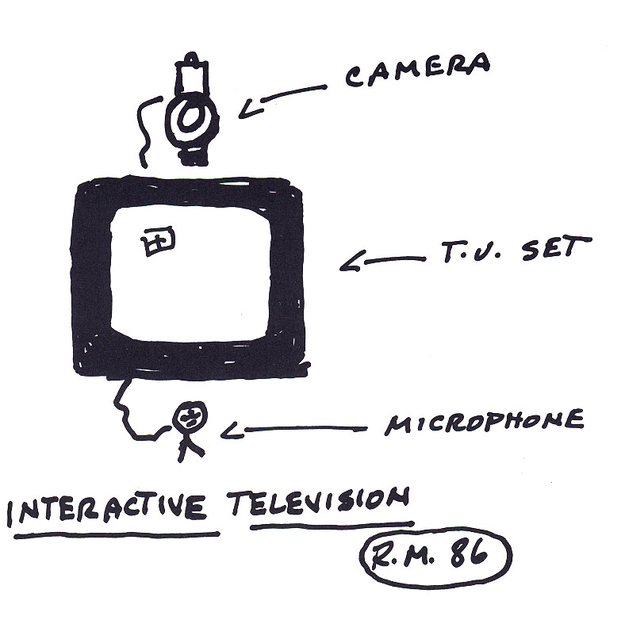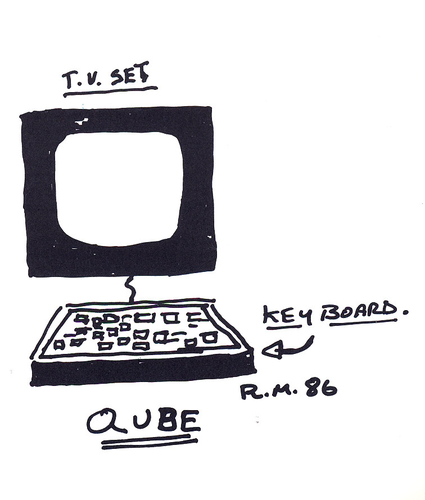In order to analyze and evaluate such matters, it is important to go beyond the limitations imposed by the art world structures and consider all aspects attached to the transitional period, mentioned above.
The implication of the transition from a second wave industrialized society to a third wave information
When dealing with areas of rapid change such as communication and electronics it is clear that using these advanced facilities is virtually pointless within the context of a consumer industrialized society, because they are in fact, the vocabulary of a new era. Culture obviously is no exception to the rule and because of this, it must confront the reconceptualization of its role in today's society.
The present situation within a cultural frame work
In this dying industrial civilization, culture and art have acquired a meaning which is totally different from the one they had in previous eras. The advent of a new civilization naturally demands a new approach to culture within the boundaries imposed by this new cycle.
In order to define such a meaning, it is important not only to consider the innovations that are pan of this new period but also the conditions in which they can be used, according to the community's needs and expectations. In the case of culture, the question boils down to the way in which all communication facilities can be used to achieve the best results while encouraging a dialogue between artists and their audiences.
Unfortunately such issues are not even considered by the cultural establishment; as Marshal McLuhan puts it: In the name of progress, our official culture is striving to force the new media to do the work of the old.
Art as commodity
In most parts of the Western World, museums and institutions alike, continue to operate within 19th century structures, in which media (film, audio, video etc.) cannot be located clearly and are regarded simply as unimportant sidelines. Thus they lack the commodity status of other more conventional disciplines such as painting, sculpture and graphics.
At best, time-based disciplines are regarded by cultural administrators as extensions of painting and sculpture and not as media in their own right. They are generally 'legitimized' by transforming them into installations, a new form of decorative electronic wallpaper, presented in 'artistically' reshaped hardware. Such a compromise can only be described as a return to the stone age with the art establishment acting as a 'Living Fossil'. More and more its function has been limited to that of an archive with no influence whatsoever on the way in which contemporary civilization is being shaped.
Redefining the role of art in today's society
Within this sterile cultural panorama, the redefinition of art and the artist's place in the community requires rapid steps towards the artist's direct participation, not only in the creative aspects of production and programming, but in the entire process of regulating communication.
Taking such a standpoint demands a new approach to the idea of what an artist is. The issue is not only the one of becoming involved with technology, but also the social, political and economical implications of this involvement.
The different possibilities at present
The combination of basic tools such as satellite and cable offers a considerable range of possibilities for programming; these are the ideal means for developing what is now described as Customized Programmation, which can be targeted at specialized audiences, not only on a local or national level, but potentially on a global scale. Standardized programming is increasingly threatened by all forms of customized programming which are better at serving the demands of a pluralistic society and are no longer interested in the information imposed by the communication monopolies, but only in what they regard to be specifically of interest to themselves.
Circulation of daily newspapers in the U.S. has decreased from 63 million in 1973 to 43 million in 1983. Simultaneously there has been a virtual explosion of mini magazines, newsletters and other publications all with continuously increasing circulations. With the appearance of new, fast and cheaper printing processes, political, religious and cultural groups can easily publish and distribute their own publications.
It is the same story with the electronic media. ABC, CBS and NBC (the major American networks) are being confronted with big audience losses because of the appearance of new, specialized networks (news, music, sports) and local cable companies.
Domestic video recorders, not only allow viewers to record TV programs by means of tuning devices, they disrupt programming and also broaden the viewers' choice by the additional possibility of the wide range of software available from video rental shops.
In addition, the relatively low cost cameras that can be used with the VCR transform the consumer into a prosumer (Consumer-Producer) who can then realize her or his own programming.
Audience development
Everyone involved in communication is well aware of the importance attached to audience development; it is a concept that communication monopolies have been dealing with for a long time although only on a commercial basis and exclusively geared toward 'mass audiences'.
The situation differs in the case of customized programming and one of the first requirements for dealing with it is the development of a new audio-visual language to help identify the new media. This is analogous to the need which existed for the creation of a newspaper vocabulary (lay out, typography etc.) that differed from the one used for books. Hence, there is a demand for a language in which analogue, digital and live components are evenly incorporated to give a new face to all new forms of programming.
Theoretical background of such a new approach in viewing and programming is an integral part of audience development. Programming in itself is not enough, particularly in the early stages; audience development is an activity that requires patience and dedication.
Potential audiences must be kept up to date on the existing possibilities by every available means; newspaper and magazine articles, conferences/debates, conventions etc.; always staning from a generalized point of view rather than a specialist one (despite the fact that customized programming is not aimed at general audiences but at specialized ones).
Producing and programming within today's structures, means operating in mobile networks instead of in pyramid-like hierarchies. This means networks that are coordinated and then come together for the final stages of the production and broadcasting: teams where concept is as important as transportation. Within such enlarged structures, issues like copyright and authorship must be thoroughly reviewed. These are concepts totally integrated within consumerism; as new technologies and ideologies enter the arena, the subject becomes controversial, especially in those cases when individual creativity is overridden by collective efforts.
Financing customized programming
On top of the wide range of advertisement possibilities opened up by local and special interest programming, there is a considerable number of alternative options in the fields of research and experimentation. For instance, some universities which are at present suffering from cutbacks in government support and private sponsorship, now work jointly with both government and private enterprise in research and development of fields such as electronics, telecommunications, bio-engineering, etc. Similar options are feasible for programmers where government bodies and private interest can work as equal partners with communicators, profiting from each other's knowledge and capabilities.
In this way, the stiff structures of official support and private patronage of the arts and sciences can be upgraded to a more egalitarian level.
Customization
It's clear by now that the mass media can no longer cope with today's communication load while still providing the variety required by today's civilization. As Alvin Toffler describes it in his book Third Wave: The future of television is the individeo, narrowcasting addressed to a single individual at a time.
Like domestic video, cable casting and computers, interactive telecommunication encourages passive audiences to become active participants of today's electronic creative process.
Satellites are the latest magic component for customized programming. In combination with cable, home satellite will allow audiences to customize their own programming. Telecommunications today are no longer in the hands of the superpowers (many nations and private concerns have their own satellites) the market is a very competitive one; the cost of satellite time has decreased so much that experts can now talk in terms of Distance Independent Communication. Because of this it is now possible to envisage temporary networks for special interest programming. By selecting whatever is most suitable for a particular type of audience, programmers will be able to choose from a wide range of possibilities on a global basis. This can be delivered instantly to subscribers via cheap fibre optics, which are at present replacing the expensive copper wire cable.
This new global communication net breaks through all geopolitical barriers. In today's structures, it is impossible to build communication frontiers. Voice of America broadcasting to Eastern Europe is an example of this as is the appearance of Transnational Nets (TNets), Music Box, Sky Channel, Europe TV etc.
A new term has entered the vocabulary of communications: Information Sovereignty.
Direct participation of audiences in programming
Unlike prepackaged programming, live radio and television have always involved audiences in events taking place at a very special point in time. Participating in live programs via telephone is one of the oldest traditions and this kind of live programming has now been broadened by all the technical developments in the field of interactive communication.
Entire towns in Western Europe, North America and Japan, are already linked directly so cable subscribers can request information, book flights, hotel reservations or even participate directly in live shows.
QUBE is an interactive system based in Colombus Ohio (US). It provides subscribers with 30 channels and a keyboard which can be used to react directly to debates, shows, interviews etc.
A town in Japan has an experimental system which includes a camera and a microphone attached to each subscriber's TV set thus enabling them to become programmers; newsreaders, announcers and interviewers often work in their homes instead of a studio.
In The Netherlands, Philips is developing a similar system. All these examples and other existing possibilities, must be considered when thinking of new forms or programming.
Measuring audience participation
In the present situation, it is impossible to measure audience response to any new form of programming using the codes imposed by mass communication. Rates and statistics simply can't work with the present structures. The information society is no longer a theoretical abstraction but a political and economical reality in which the problem is not to satisfy the majority. Instead, it are minorities who are becoming the issue, so new codes must be invented to measure their requirements.
The times when networks dictated what was to be watched and when, are over. It is impossible now to envisage Orwell's's faceless civilization manipulated by mass communication. With the means available, the future offers opportunities for the creation of a new culture, rich in life styles and different approaches towards the meaning of existence, a very fertile ground for the creative work of an artist.
If you'd like to quote something: Marroquin, Raul. "Visual Arts and Customized Programming." ''Mediamatic Magazine vol. 1 # 1 (1986).
